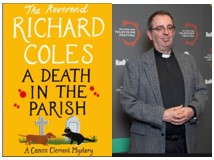A review by John Cook.

I admit to being an Anthony Horowtiz fan and enjoying Midsomer. The English have a knack for combining life in quaint villages and small towns that produce an alarming rate of strange deaths and murders with a linking character digging into these oddities (new and old) to crack the mystery (sometimes with an Agatha Christie ending, sometimes not). This book has the added attraction of being authored by an Anglican priest who knows some of the inside running on small country parishes and their relations with the community including the Lord of the Manor (think Dibley without the jokes). Even the aristocracy under division within the family and the arrival of a potential future chatelaine who has Canadian First Nation ancestry! Thanks to my Mother, I received the Bracknell luxuries of induction into our local Moderately High Church of England (St Albans – you can’t get much more English than that!). In later life, I also had at least two close friends who were Anglican priests who segued into psychology and Counseling. So, I am poised to see what is happening in Upper and Lowers Badsapple starting with plumbing the mysteries of transubstantiation. An indication of what lies ahead?
Coles is still wrestling with the problem of his priesthood and natural being.
In April 2022, Coles announced that he retired from parish duties due to the Church of England allegedly increasingly excluding gay couples, and what he described as its “conservative, punchy and fundamentalist” direction
Coles is most definitely a gay man having come out at 16 to his mother while playing “Glad to be Gay’ four times. He had some privilege in his background attending good schools. He had a strong interest in the arts and music and went through a period when he played with Jimmy Somerville in the Communards! He later discovered theology and became an Anglican priest which has been nil today. Our priest, Daniel, is presented as rector of two combined parishes with a newly-arrived evangelical curate, Chris, who flags his alternative lifestyle in his vehicle, clothing, religious thought and observances and two teenage wannabe Goth children. This is a well-known Anglican divide best represented in this country by the difference between the Diocese of Sydney and pretty much everyone else.
‘“ Oh dear.” There you go. Where’s your fight? Where’s your shaking the dust from your shoes, where are your sheep and your goats, your wheat and your tares? You’re so … Anglican.’ ‘Aren’t you?’ ‘I’m a Bible Christian, Daniel. Aren’t you?
“Chris Biddle was full of conviction, and when he was with him Daniel sometimes felt like a genial Liverpudlian Fabian being hectored by Militant Tendency.”
As a consequence, his writings relate well to the small county towns he knows well, with the odd gay twist. Everything in this village has potential ranging from past histories, occupations and homes. Even vehicles are usually symbolic of their drivers and their use – think Land Rover or Van den Plas. It is to be expected that dogs will play a role in daily lives and we are treated to two miniature dachshunds owned by the Rector and his Mother, (they are Hilda who eventually gives birth, think the church and Cosmo, A well-known Archbishop of Canterbury)
While things begin with the shocking murder and we are treated to the long process of the priest’s mulling over possibilities while carrying out his priestly responsibilities, we are treated to the kinds of inner thoughts of an individual in this situation. I enjoyed so much of the detail in this book ranging from the houses, businesses and the relevant histories of village folk including one Dickensian set of characters, the Talbys, who appear almost magically when someone is in decline and lacks support. They attach themselves limpet-like to the situation, reacting badly to any challenge while pocketing what they can from the present situation and any post-mortem. Make sure you know what a ‘caduceus’ is. I would agree that my past religious and friendship experiences probably gave me more enjoyment from what Daniel was thinking and doing especially when it came to services, litany and choices of readings and hymns. Some readers may have more problems with accessing this.
The story starts with a bang as a teen boy is found with his throat cut Aztec-style on the altar of a disused chapel in a local wartime airfield. There are red herrings aplenty as we are introduced to the locality through the priest’s eye, experiences and memories of a series of murders in the same village just one year ago solved with the assistance of a local detective who seems more than usually friendly (Think Grandchester with homosexual leanings). The final act is heralded by that most English of village events – Guy Fawkes or Bonfire Night. There have to be mixed feelings for anyone who thinks about its origins and any relevance to contemporary thinking or behaviour beyond loud noises and colourful displays. Given that events started with the shedding of blood, there is something natural about the cleansing clarity of fire leading to an Agatha Christie drawing room conclusion.
The real conclusion is cleverly left to literally the last line after a trail of hints and suggestions throughout the whole book. This offering is the second in a sequence that now must be extended. I want it!
BCC Library has 1 copy, 10 holds as at reading
